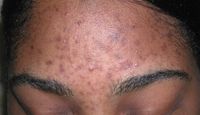- General Dermatology
- Eczema
- Chronic Hand Eczema
- Alopecia
- Aesthetics
- Vitiligo
- COVID-19
- Actinic Keratosis
- Precision Medicine and Biologics
- Rare Disease
- Wound Care
- Rosacea
- Psoriasis
- Psoriatic Arthritis
- Atopic Dermatitis
- Melasma
- NP and PA
- Skin Cancer
- Hidradenitis Suppurativa
- Drug Watch
- Pigmentary Disorders
- Acne
- Pediatric Dermatology
- Practice Management
- Prurigo Nodularis
Article
Special considerations: Exacerbating factors mandate acne treatments for ethnic skin
Topical retinoid treatment is the mainstay of acne management in ethnic skin, as it is in fairer individuals. However, additional considerations are needed to address the unique postinflammatory sequelæ in dark skin and precipitating factors for acne eruptions.

Key Points

"Acne vulgaris ranks as the most common dermatologic disease, regardless of skin type, and its pathophysiology is the same in light and ethnic skin.
"However, there are special considerations for acne management in ethnic skin that must be taken into account to optimize outcomes," says Dr. Callender, clinical assistant professor of dermatology, Howard University College of Medicine, and a private practitioner in Mitchellville, Md.
The role of cosmetic grooming aids in the development of acne-like lesions tends to be a more prominent issue in skin of color. Pomade use on the hair, which is particularly practiced by blacks, can block follicular openings in skin along the hairline, leading to inflammatory papules and comedone formation.
In addition, use of thick, opaque, oil-based makeup to camouflage hyperpigmented macules that tend to develop as a postinflammatory response to acne lesions in ethnic skin can be a source of "acne cosmetica."
"Skin-of-color patients may be more concerned about the impact of postinflammatory hyperpigmentation (PIH) on their appearance than the acne lesions, and use of makeup to conceal the darkened areas sets up a vicious cycle, exacerbating the acne and worsening the hyperpigmentation," Dr. Callender tells Dermatology Times.

PIH
Another interesting feature of acne in skin of color derives from a histological study conducted by Rebat Halder, M.D., who discovered that comedonal acne in blacks may be inflammatory. This finding also has implications for the development of PIH.
In addition, clinicians need to consider that PIH can arise in ethnic skin as a consequence of the medications used for acne treatment. Whereas adverse reactions to topical medications in lighter-skinned patients typically present as peeling, scaling and erythema, in patients of color, contact irritation from acne medications is more likely to result in hyperpigmentation or even subtle hypopigmentation, Dr. Callender says.
Treatment algorithm
The treatment algorithm for acne in skin of color is based on combination therapy, regardless of disease severity.
Initial treatment for mild acne should combine a topical retinoid with benzoyl peroxide and/or a topical antibiotic as needed for the short term.
Hydroquinone 4 percent is also incorporated into the treatment regimen as a spot treatment for PIH, although results from clinical trials evaluating tretinoin, tazarotene and adapalene show that all of these topical retinoids effectively minimize acne-associated hyperpigmentation.
"The mechanism for this additional benefit may be multimodal. Retinoids can cause melanin granule dispersion, inhibit induction of tyrosinase and melanogenesis, and promote keratinocyte proliferation and differentiation," Dr. Callender says.
For more moderately severe acne, it may be necessary to introduce oral antibiotics, while other cosmetic procedures, microdermabrasion or chemical peels, might be considered in addition to hydroquinone for treating both acne and PIH.
Use of a salicylic acid peel may be especially helpful, since this lipophilic agent has good follicular penetration.
Acne management
Acne management in patients of color may also need to address keloids and hypertrophic scarring with the use of intra-lesional triamcinolone acetonide 20 mg/ml to 40 mg/ml.
These lesions can especially develop as a sequela to inflammatory cysts and nodules, although, fortunately, nodolucystic acne tends to occur less often in skin-of-color patients relative to their lighter-skinned counterparts.
Disclosure: Dr. Callender is a clinical researcher, speaker, consultant and advisory board member for many companies that market products for acne and pigmentary disorders.





